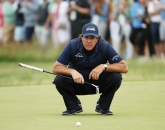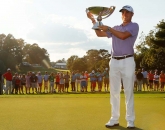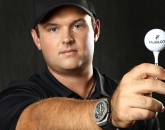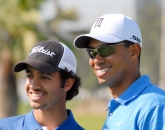My week in East London concluded with a trip to play golf at Fish River Sun near Port Alfred, an hour's drive away. It was a lovely coastal journey on a delightfully uncluttered road, beneath a classic South African "high sky". We were doing a reasonably legal 70 miles per hour when we turned a bend to find a large convoy of heavy trucks approaching us, with barely a 9-iron separating any of them. That was unfortunate because a seriously underpowered jalopy had decided to try and overtake all of them. Closing at about 140 mph a full-frontal meeting looked a distinct possibility. Whilst applying maximum pressure to the brake pedal, my suddenly alert mind was weighing up the options (which were distinctly limited) when the probably equally surprised driver of the suicide vehicle swerved onto the grass verge on my side of the road, giving us a free passage. Being South Africa, I decided that I would leave them to it and continue on our way. How fortunate, though, that we had not both decided to take the same avoiding action at the same instant! It was hugely impressive that my friend and colleague Dominik Holyer, who was sitting in the passenger seat, showed no sign of alarm or panic and merely continued to describe the delights of his home club, Hockley, near Winchester in the English Home Counties. The somewhat ungrateful fellow then proceeded to thrash me on the Gary Player-designed layout, using a particularly manky set of hire clubs, whilst I had my own finely tuned set with me. Not my best day.
As a fascinating build-up to September's Ryder Cup in Scotland, I thought I would recount a few memories of the 12 previous editions that I have covered for various different organisations. Unlike American golf coverage (actually unlike most of their sporting coverage) it seems sensible to do this in chronological order, hence some recollections of Kiawah Island in 1991. I had attended the 1989 Cup at The Belfry, but really only as an observer for BBC Radio. In The Deep South I was being allowed out on my own as one of three "lead" commentators on the course. Each of us had an expert with us. Mine was the former Ryder Cup star Tommy Horton, who mucked in with great relish. It was the first time that full coverage on the radio had ever been attempted from America. To do it using the now normal satellite network would have been hugely expensive so the decision had been taken to do day-long, "ball by ball" coverage on a single ISDN telephone line. It was a huge gamble but it worked perfectly throughout. It did however involve somebody carrying an even heavier and more awkward backpack than the contraptions we carry now. Fortunately we had persuaded some American students to undertake the role of packman, which they appeared to love as they got an up close and personal view of their golfing heroes. Mine was a chap called Cary, who was inevitably dubbed "Cary the Pack". Unfortunately, halfway through the second day of searing heat and high humidity, Cary needed a bathroom break. Temporarily handing the equipment to Tommy Horton he dashed to the nearest Portaloo, promising to catch us up at the next tee. Cary was never seen again, and Tommy insisted on assuming the load for the remainder of the day.
The whole experience at Kiawah was totally memorable, not least because it was unlike anything most of us had ever encountered before. Journeying through the old Deep South Plantations to this remote new complex was like visiting an alien world. My colleagues were the renowned football commentator Alan Green from Northern Ireland, and the late "whispering" George Bailey, a lifetime County golfer from Newcastle, who was one of golf and life's great enthusiasts. By then though he was not in the first flush of youth, and the gruelling environment was taking its toll. By the Saturday night he was exhausted, and at dinner that evening, he sat with arms folded, gently nodding off. George was renowned for his hairpiece and his flat cap. Remarkably both always seemed to stay in place even in the strongest wind. However that night we all sat mesmerised as his head gradually slid forward over his bowl of soup. Would the wig end up in the mulligatawny? Or would he just do a face plant? In the end sadly it was neither, but it caused huge mirth.
I got my comeuppance big time the next day. After watching the querulous Mark Calcavecchia surrender a dormie four lead to the only slightly less nerve-jangled rookie Colin Montgomerie, I eventually dropped back to see the conclusion of the Hale Irwin/Bernhard Langer encounter. The atmosphere was electric, with Irwin showing signs of needing a better psychologist than Calcavecchia's. On the 16th Langer had a putt of six feet or so to win the hole. I knew the situation, but I heard Alan Green telling our producer on talkback that if Langer missed, that was it, game over. After a very long week, I stupidly believed what I heard in my ear. Langer missed and I went into the full "that's it, Irwin wins, and with it the United States regain the Ryder Cup, what drama, what emotion …” There was a long pause and then Tony Adamson and Renton Laidlaw (who had already lost most of their notes in the strong wind blowing through their tower behind the 18th) calmly picked up: "So the final match is all square with everything to play for …" There wasn't a hole deep enough for me to bury myself in. We later read that thousands of motorists listening on their car radios back in Britain had pulled in to the side of the road, all the more to enjoy the drama. They must have loved that!
Afterwards, I vividly remember the late Payne Stewart's floods of joyful tears and later, the terrific performances of Ian Woosnam and Sam Torrance on the table tops of the tented public bars. The Americans loved it. So did we.
Of course all the wives were present for that one.
Pages
Click here to see the published article.











